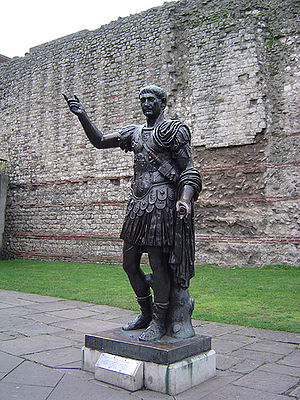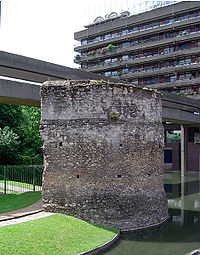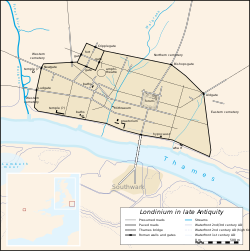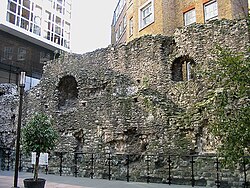London Wall: Difference between revisions
mNo edit summary |
m →Later use and remains: clean up, replaced: medieval → mediæval |
||
| Line 36: | Line 36: | ||
The wall's moat has also left its mark on London; it forms the line of the street of Houndsditch. This was once London's main rubbish disposal site and was notorious for its appalling odour; its name, according to the 16th-century historian John Stow, was derived "from that in old time, when the same lay open, much filth (conveyed forth of the City) especially dead dogges were there laid or cast." The moat was finally covered over and filled in at the end of the 16th century, becoming the present street. | The wall's moat has also left its mark on London; it forms the line of the street of Houndsditch. This was once London's main rubbish disposal site and was notorious for its appalling odour; its name, according to the 16th-century historian John Stow, was derived "from that in old time, when the same lay open, much filth (conveyed forth of the City) especially dead dogges were there laid or cast." The moat was finally covered over and filled in at the end of the 16th century, becoming the present street. | ||
During the Great Fire of London in September 1666, almost all of the | During the Great Fire of London in September 1666, almost all of the mediæval City of London inside the wall was destroyed. | ||
Today all that remains of the wall are a few (albeit substantial) fragments, some of which can be seen in the grounds of the Museum of London, in the Barbican Estate and around [[Tower Hill, London|Tower Hill]]. A section near the Museum of London was revealed at Noble Street, after the devastation of an air raid on 29 December 1940 at the height of the Blitz. Another visible section is at St Alphage Gardens, and other sections form part of the walls or foundations of modern buildings and are only visible from inside those buildings. One of the largest and most readily accessed fragments of the wall stands just outside Tower Hill tube station, with a replica statue of the Emperor Trajan standing in front of it. | Today all that remains of the wall are a few (albeit substantial) fragments, some of which can be seen in the grounds of the Museum of London, in the Barbican Estate and around [[Tower Hill, London|Tower Hill]]. A section near the Museum of London was revealed at Noble Street, after the devastation of an air raid on 29 December 1940 at the height of the Blitz. Another visible section is at St Alphage Gardens, and other sections form part of the walls or foundations of modern buildings and are only visible from inside those buildings. One of the largest and most readily accessed fragments of the wall stands just outside Tower Hill tube station, with a replica statue of the Emperor Trajan standing in front of it. | ||
Revision as of 10:41, 30 January 2021




London Wall was the defensive city wall of the City of London, of which now only remnants stand but whose line defined the city's boundary precisely until the later Middle Ages. The wall was first built by the Romans around Londinium, a strategically important port town on the River Thames and later the chief town of Britannia. The wall was maintained until the 18th century.
The City of London is the only town in Middlesex to have been a walled town, and the remaining parts of the wall are amongst the most remarkable Roman remains in the south-eastern counties.
The wall also is now the name of a road in the City running along part of the course of the old wall between Wormwood Street and the Rotunda junction where St. Martin's Le Grand meets Aldersgate Street.
Construction of the Roman wall
The wall appears to have been built in the late 2nd or early 3rd century, certainly between 190 and 225, and probably between 200 and 220.[1] This was around 80 years after the construction in 120 of the city's fort, whose north and west walls were thickened and doubled in height to form part of the new city wall. It continued to be developed until at least the end of the 4th century, making it among the last major building projects undertaken by the Romans before the Roman retreat from Britain around 410.
Although the exact reason for the wall's construction is unknown, it may have been connected to the invasion of northern Britain by Picts who overran Hadrian's Wall in the 180s.[2] Alternatively, many historians link the building of London Wall with the political crisis that had emerged in the 190s when two men – Septimius Severus, and the governor of Britain Clodius Albinus – claimed the right to succession as emperor. The wall may have been constructed on the orders of Albinus in the 190s, who, in a power struggle with his rival, may have felt the need to protect his capital. Septimius eventually defeated his rival in 197.
Along with Hadrian's Wall and the road network, the London Wall was one of the largest construction projects carried out in Roman Britain. The wall was constructed largely from Kentish ragstone brought by water from Maidstone. It has been calculated that some 1,300 barge journeys would have been required to transport the 85,000 tons of stone from Kent. Once built, the wall was two miles long, enclosed an area of about 330 acres, and was 6 to 9 feet wide and about 20 feet high.[3] It had a ditch or fossa in front of the outer wall, measuring some 6 feet deep by between 9 and 15 feet wide. It included a number of bastions (at least twenty-two) spaced about 70 yards apart, on the eastern section of the wall.[4]
The economic stimulus provided by the wall and Septimius's campaigns of conquest in Caledonia appear to have revived Londinium's fortunes somewhat in the early third century.
Gates
The wall had a number of gates around the outside that led to important Roman roads, leading to other towns in the country. The original gates on the wall going clockwise from Ludgate in the west to Aldgate in the east were: Ludgate, Newgate, Cripplegate, Bishopsgate and Aldgate. Aldersgate, between Newgate and Cripplegate, was added around 350,[5] and Moorgate, between Cripplegate and Bishopsgate, was built later still, in the Middle Ages. These bring the number of gates up to the seven commemorated in London tradition and literature. Some of the gates, though now long gone, are remembered by the areas or roads where the gates stood being named after them. Due to the rapid growth of the city, the number of gates was increased to cope with the extra traffic in the Middle Ages, and the walls were also strengthened and built upon.
The boundaries of the City of London ceased to coincide with the old city wall as the city expanded its jurisdiction slightly during the later Middle Ages. The city's jurisdiction expanded westwards, crossing the historic western border of the original settlement – the River Fleet – along Fleet Street to Temple Bar. The city also took in the other "city bars," toll gates which were situated just beyond the old walled area: Holborn Bar, Smithfield Bar, and Whitechapel Bar. These were the important entrances to the city and their control was vital in maintaining the city's special privileges over certain trades.
The seven gates to the City of London, with many repairs and rebuilding over the years, stood until they were all demolished between 1760 and 1767.[6]
Riverside Wall
In the late third century, Londinium was raided on several occasions by Saxon pirates. This led, from around 280 onwards,[5] to the construction of an additional riverside wall.
Later use and remains
The wall remained in active use as a fortification for more than 1,000 years afterwards. It was used to defend London against raiding Saxons in 457, but abandoned when the Saxons occupied southern Britain, and a new London developed outside the old Roman city. It was Alfred the Great who removed London back inside the shelter of the London Wall, thus re-establishing the City of London where it now stands, and repairing the wall. The wall was redeveloped in the Middle Ages with the addition of crenellations, more gates and further bastions.
It was not until as late as the 18th and 19th centuries that the wall underwent substantial demolition, although even then large portions of it survived by being incorporated into other structures. Amid the devastation of the Blitz, some of the tallest ruins in the bomb-damaged City were remnants of the Roman wall.
The wall's moat has also left its mark on London; it forms the line of the street of Houndsditch. This was once London's main rubbish disposal site and was notorious for its appalling odour; its name, according to the 16th-century historian John Stow, was derived "from that in old time, when the same lay open, much filth (conveyed forth of the City) especially dead dogges were there laid or cast." The moat was finally covered over and filled in at the end of the 16th century, becoming the present street.
During the Great Fire of London in September 1666, almost all of the mediæval City of London inside the wall was destroyed.
Today all that remains of the wall are a few (albeit substantial) fragments, some of which can be seen in the grounds of the Museum of London, in the Barbican Estate and around Tower Hill. A section near the Museum of London was revealed at Noble Street, after the devastation of an air raid on 29 December 1940 at the height of the Blitz. Another visible section is at St Alphage Gardens, and other sections form part of the walls or foundations of modern buildings and are only visible from inside those buildings. One of the largest and most readily accessed fragments of the wall stands just outside Tower Hill tube station, with a replica statue of the Emperor Trajan standing in front of it.
In 1984 the Museum of London set up a Wall Walk from the Tower of London to the museum, using 23 tiled panels.[7] A number of these have been destroyed in subsequent years.[8] At Noble Street, the panels were replaced by etched glass panels. These were intended as a prototype for new panels along the entire walk, but no further replacements have been made.
Within and Without the Wall
The suffix words "Without" and "Within" denote whether an area of the City – and usually applied to the wards – fell outside or within the London Wall, though only Farringdon and (formerly) Bridge have been split into separate wards this way (Bridge Without falling beyond the gates on London Bridge). Some wards – Aldersgate, Bishopsgate and Cripplegate – cover an area that was both within and outside the wall and, although not split into separate wards, often the part (or "division") within the Wall is denoted (on maps, in documents, etc.) as being "within" and the part outside the Wall as being "without". Archaically "Infra" (within) and "Extra" (without) were also used[9] and the terms "intramural" and "extramural"[10] are also used to describe being within or outside the walled part of the city.
Outside links
| ("Wikimedia Commons" has material about London Wall and its gates) |
- Museum of London
- PhotoEssay on London Walls with markers
- London Wall Walk photos geocoded on Flickr
- London Wall Walk Narrated Video Tour
References
- ↑ Ross & Clark 2008, p. 47.
- ↑ Channel4.com Timeline of Romans in Britain
- ↑ London Wall - Museum of London
- ↑ Those on the western section, such as the well-preserved example that can be seen at the Barbican Estate, next to the church of St Giles-without-Cripplegate, were added in the 13th century (Chapman, Hall & Marsh 1986, nos. 15–17).
- ↑ 5.0 5.1 Ross & Clark 2008, p.47.
- ↑ Seven gates to the The City of London
- ↑ London Wall Walk Museum of London, Retrieved 21 May 2010.
- ↑ Shows status of the panels in January 2006 Retrieved 21 May 2010.
- ↑ {{brithist|31909)
- ↑ Mapping London: Making Sense of the City, Simon Foxell, p 17
- Chapman, Hugh, Hall, Jenny, and Marsh, Geoffrey (1986), The London Wall Walk London: Museum of London.
- Ross, Cathy, & Clark, John, eds. (2008), London: The Illustrated History. London: Allen Lane.
- Smith, A. (1970), Dictionary of City of London Street Names. London: David & Charles.
